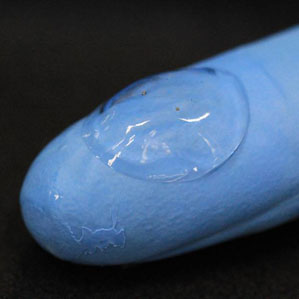Contact Lens Computer: Like Google Glass, without the Glasses
For those who find Google Glass indiscreet, electronic contact lenses that outfit the user’s cornea with a display may one day provide an alternative. Built by researchers at several institutions, including two research arms of Samsung, the lenses use new nanomaterials to solve some of the problems that have made contact-lens displays less than practical.

A group led by Jang-Ung Park, a chemical engineer at the Ulsan National Institute of Science and Technology, mounted a light-emitting diode on an off-the-shelf soft contact lens, using a material the researchers developed: a transparent, highly conductive, and stretchy mix of graphene and silver nanowires. The researchers tested these lenses in rabbits—whose eyes are similar in size to humans’—and found no ill effects after five hours. The animals didn’t rub their eyes or grow bloodshot, and the electronics kept working. This work is described online in the journal Nano Letters.
A handful of companies and researchers have developed electronic contact lenses over the past five years. Sensimed, of Switzerland, makes a lens for 24-hour monitoring of eye pressure in glaucoma patients, and other researchers, including University of Washington professor and Google Glass project founder Babak Parviz, have built contact-lens displays. But these devices have used rigid or nontransparent materials.
Park wants to make contact lenses that have all the functions of a wearable computer but remain transparent and soft. “Our goal is to make a wearable contact-lens display that can do all the things Google Glass can do,” he says. To make it work, they needed a transparent, highly conductive material that was also flexible. The transparent conductor of choice in conventional rigid electronics, indium tin oxide, is brittle, and it must be deposited at high temperatures that would melt a contact lens. Organic conductors, graphene, and nanowires are flexible and transparent, but they’re not conductive enough.
Park, working with Sung-Woo Nam of the University of Illinois at Urbana-Champaign, found that sandwiching silver nanowires between sheets of graphene yielded a composite with much lower electrical resistance than either material alone. The industry standard for a transparent conductor is a resistance of 50 ohms per square or less, says Nam; their material has a resistance of about 33 ohms per square. The material also transmits 94 percent of visible light, and it stretches. The researchers make these conductive sheets by depositing liquid solutions of the nanomaterials on a spinning surface, such as a contact lens, at low temperatures.
Working with researchers at Samsung, they coated a contact lens with the stretchy conductor, then placed a light-emitting diode on it. Although it would be an exaggeration to call this a display, since there is just one pixel, it’s possible this kind of material will be a necessary component in future contact-lens displays, says Herbert De Smet, who works on electronic contact lenses at Ghent University in Belgium but was not involved with the work.
Nam believes medical applications of electronic contact lenses may be even more promising than eyeball-mounted displays. He is currently using the graphene-nanowire conductors to make biosensors that could monitor health conditions by sampling the chemistry of the eye’s tear film. And De Smet’s group is developing lenses that can actively filter light to compensate for vision problems.
Deep Dive
Computing
Inside the hunt for new physics at the world’s largest particle collider
The Large Hadron Collider hasn’t seen any new particles since the discovery of the Higgs boson in 2012. Here’s what researchers are trying to do about it.
How ASML took over the chipmaking chessboard
MIT Technology Review sat down with outgoing CTO Martin van den Brink to talk about the company’s rise to dominance and the life and death of Moore’s Law.
How Wi-Fi sensing became usable tech
After a decade of obscurity, the technology is being used to track people’s movements.
Algorithms are everywhere
Three new books warn against turning into the person the algorithm thinks you are.
Stay connected
Get the latest updates from
MIT Technology Review
Discover special offers, top stories, upcoming events, and more.